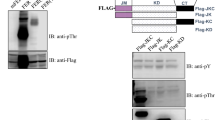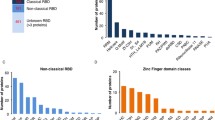Abstract
The Arabidopsis thaliana glycine-rich domain protein 2 (AtGRDP2) gene encodes a protein of unknown function that is involved in plant growth and salt stress tolerance. The AtGRDP2 protein (787 aa, At4g37900) is constituted by three domains: a DUF1399 located at the N-terminus, a potential RNA Recognition Motif (RRM) in the central region, and a short glycine-rich domain at the C-terminus. Herein, we analyzed the subcellular localization of AtGRDP2 protein as a GFP translational fusion and found it was localized in the cytosol and the nucleus of tobacco leaf cells. Truncated versions of AtGRDP2 showed that the DUF1399 or the RRM domains were sufficient for nuclear localization. In addition, we performed a yeast two-hybrid split-ubiquitin assay (Y2H) to identify potential interactors for AtGRDP2 protein. The Y2H assay identified proteins associated with RNA binding functions such as PABN3 (At5g65260), EF-1α (At1g07920), and CL15 (At3g25920). Heterodimeric associations in planta between AtGRDP2 and its interactors were carried out by Bimolecular Fluorescence Complementation (BiFC) assays. The data revealed heterodimeric interactions between AtGRDP2 and PABN3 in the nucleus and AtGRDP2 with EF-1α in the cytosol, while AtGRDP2-CL15 associations occurred only in the chloroplasts. Finally, functional characterization of the protein-protein interaction regions revealed that both DUF1399 and RRM domains were key for heterodimerization with its interactors. The AtGRDP2 interaction with these proteins in different compartments suggests that this glycine-rich domain protein is involved in post-transcriptional processes.








Similar content being viewed by others
References
Belda-Palazón, B., Ruiz, L., Martí, E., Tárraga, S., Tiburcio, A. F., Culiáñez, F., et al. (2012). Aminopropyltransferases involved in polyamine biosynthesis localize preferentially in the nucleus of plant cells. PLoS One 7.https://doi.org/10.1371/journal.pone.0046907
Bobik K, Fernandez JC, Hardin SR, Ernest B, Ganusova EE, Staton ME et al (2019) The essential chloroplast ribosomal protein uL15c interacts with the chloroplast RNA helicase ISE2 and affects intercellular trafficking through plasmodesmata. New Phytol. 221:850–865. https://doi.org/10.1111/nph.15427
Bocca SN, Magioli C, Mangeon A, Junqueira RM, Cardeal V, Margis R et al (2005) Survey of glycine-rich proteins (GRPs) in the Eucalyptus expressed sequence tag database (ForEST). Genet. Mol. Biol. 28:608–624. https://doi.org/10.1590/S1415-47572005000400016
Ferrando A, Koncz-Kálmán Z, Farràs R, Tiburcio A, Schell J, Koncz C (2001) Detection of in vivo protein interactions between Snf1-related kinase subunits with intron-tagged epitope-labelling in plants cells. Nucleic Acids Res. 29:3685–3693. https://doi.org/10.1093/nar/29.17.3685
Gietz RD, Schiestl RH (2007) High-efficiency yeast transformation using the LiAc/SS carrier DNA/PEG method. Nat. Protoc. 2:31–34. https://doi.org/10.1038/nprot.2007.13
Hernández-Lucero E, Rodríguez-Hernández AA, Ortega-Amaro MA, Jiménez-Bremont JF (2014) Differential expression of genes for tolerance to salt stress in common bean (Phaseolus vulgaris L.). Plant Mol. Biol. Report. 32:318–327. https://doi.org/10.1007/s11105-013-0642-8
Hooper CM, Castleden IR, Tanz SK, Aryamanesh N, Millar AH (2017) SUBA4: the interactive data analysis centre for Arabidopsis subcellular protein locations. Nucleic Acids Res. 45:D1064–D1074. https://doi.org/10.1093/nar/gkw1041
Hunt AG, Xing D, Li QQ (2012) Plant polyadenylation factors: conservation and variety in the polyadenylation complex in plants. BMC Genomics 13:641. https://doi.org/10.1186/1471-2164-13-641
Jiménez‑Bremont, J. F., Ortega‑Amaro, M. A., Hernández‑Sánchez, I. E., Rodriguez‑Piña, A. L., and Maruri‑Lopez, I. (2018). “Plant glycine-rich proteins and abiotic stress tolerance,” in Metabolic Adaptations in Plants During Abiotic Stress (CRC Press), 203–212. https://doi.org/10.1201/b22206-17.
Kim JS, Park SJ, Kwak KJ, Kim YO, Kim JY, Song J et al (2007) Cold shock domain proteins and glycine-rich RNA-binding proteins from Arabidopsis thaliana can promote the cold adaptation process in Escherichia coli. Nucleic Acids Res. 35:506–516. https://doi.org/10.1093/nar/gkl1076
Kim MH, Sonoda Y, Sasaki K, Kaminaka H, Imai R (2013) Interactome analysis reveals versatile functions of Arabidopsis cold shock domain protein 3 in RNA processing within the nucleus and cytoplasm. Cell Stress Chaperones 18:517–525. https://doi.org/10.1007/s12192-012-0398-3
Kosugi S, Hasebe M, Matsumura N, Takashima H, Miyamoto-Sato E, Tomita M et al (2009) Six classes of nuclear localization signals specific to different binding grooves of importin alpha. J. Biol. Chem. 284:478–485. https://doi.org/10.1074/jbc.M807017200
Lorković ZJ, Barta A (2002) Genome analysis: RNA recognition motif (RRM) and K homology (KH) domain RNA-binding proteins from the flowering plant Arabidopsis thaliana. Nucleic Acids Res. 30:623–635. https://doi.org/10.1093/nar/30.3.623
Mangeon A, Junqueira RM, Sachetto-Martins G (2010) Functional diversity of the plant glycine-rich proteins superfamily. Plant Signal. Behav. 5:99–104. https://doi.org/10.4161/psb.5.2.10336
Möckli N, Deplazes A, Auerbach D (2008) Finding new protein interactions using the DUALhunter system. Nat. Methods 5:i–ii. https://doi.org/10.1038/nmeth.f.204
Mousavi A, Hotta Y (2005) Glycine-rich proteins: a class of novel proteins. Appl. Biochem. Biotechnol. 120:169–174. https://doi.org/10.1385/abab:120:3:169
Ortega-Amaro MA, Rodríguez-Hernández AA, Rodríguez-Kessler M, Hernández-Lucero E, Rosales-Mendoza S, Ibáñez-Salazar A et al (2015) Overexpression of AtGRDP2, a novel glycine-rich domain protein, accelerates plant growth and improves stress tolerance. Front. Plant Sci. 5:782. https://doi.org/10.3389/fpls.2014.00782
Ortega-Amaro MA, Rodríguez-Kessler M, Rodríguez-Hernández AA, Becerra-Flora A, Rosales-Mendoza S, Jiménez-Bremont JF (2016) Overexpression of AtGRDP2 gene in common bean hairy roots generates vigorous plants with enhanced salt tolerance. Acta Physiol. Plant. 38:1–6. https://doi.org/10.1007/s11738-016-2083-0
Rodríguez-Hernández AA, Muro-Medina CV, Ramírez-Alonso JI, Jiménez-Bremont JF (2017) Modification of AtGRDP1 gene expression affects silique and seed development in Arabidopsis thaliana. Biochem. Biophys. Res. Commun. 486:252–256. https://doi.org/10.1016/j.bbrc.2017.03.015
Rodríguez-Hernández AA, Ortega-Amaro MA, Delgado-Sánchez P, Salinas J, Jiménez-Bremont JF (2014) AtGRDP1 gene encoding a glycine-rich domain protein is involved in germination and responds to ABA signalling. Plant Mol. Biol. Report. 32:1187–1202. https://doi.org/10.1007/s11105-014-0714-4
Sachetto-Martins G, Franco LO, de Oliveira DE (2000) Plant glycine-rich proteins: a family or just proteins with a common motif? Biochim. Biophys. Acta - Gene Struct. Expr. 1492:1–14. https://doi.org/10.1016/S0167-4781(00)00064-6
Saito T, Sugimoto K, Adachi Y, Wu Q, Mori KJ (2000) Cloning and characterization of amphibian cold inducible RNA-binding protein. Comp. Biochem. Physiol. Part B Biochem. Mol. Biol. 125:237–245. https://doi.org/10.1016/S0305-0491(99)00174-1
Sasikumar AN, Perez WB, Kinzy TG (2012) The many roles of the eukaryotic elongation factor 1 complex. Wiley Interdiscip. Rev. RNA 3:543–555. https://doi.org/10.1002/wrna.1118
Schneider CA, Rasband WS, Eliceiri KW (2012) NIH Image to ImageJ: 25 years of image analysis. Nat. Methods 9:671–675. https://doi.org/10.1038/nmeth.2089
Schöning JC, Streitner C, Meyer IM, Gao Y, Staiger D (2008) Reciprocal regulation of glycine-rich RNA-binding proteins via an interlocked feedback loop coupling alternative splicing to nonsense-mediated decay in Arabidopsis. Nucleic Acids Res. 36:6977–6987. https://doi.org/10.1093/nar/gkn847
Wang L, Liu Y, Aslam M, Jakada BH, Qin Y, Cai H (2021) The glycine-rich domain protein GRDP2 regulates ovule development via the auxin pathway in Arabidopsis. Front. Plant Sci. 12:1–16. https://doi.org/10.3389/fpls.2021.698487
Zhao X, Qiu T, Feng H, Yin C, Zheng X, Yang J et al (2021) A novel glycine-rich domain protein, GRDP1, functions as a critical feedback regulator for controlling cell death and disease resistance in rice. J. Exp. Bot. 72:608–622. https://doi.org/10.1093/jxb/eraa450
Zhong Y-S, Mita K, Shimada T, Kawasaki H (2006) Glycine-rich protein genes, which encode a major component of the cuticle, have different developmental profiles from other cuticle protein genes in Bombyx mori. Insect Biochem. Mol. Biol. 36:99–110. https://doi.org/10.1016/j.ibmb.2005.07.005
Acknowledgements
We thank Michael F. Dunn for critical reading of the manuscript. Special acknowledgments to Martha Torres from Centro de Ciencias Genómicas (CCG), Daniel Tapia Maruri from Centro de Desarrollo de Productos Bióticos-Instituto Politécnico Nacional (CEPROBI-IPN), and Alicia Becerra Flora and Enrique González Pérez from Instituto Potosino de Investigación Científica y Tecnológica (IPICYT) for their technical assistance.
Funding
Funding for this project was supported by CONACYT (Ciencia Básica A1-S-25233).
Author information
Authors and Affiliations
Contributions
SCB, IML, MAOA, and JFJB planned and designed research; SCB, IML, and MAOA performed experiments; SCB, IML, and COV analyzed data; reagents, materials, and equipment were provided by JFJB and MS. Data interpretation and manuscript preparation were realized by SCB, IML, MAOA, COV, MS, and JFJB. All authors read and approved the manuscript.
Corresponding author
Ethics declarations
Consent for publication
The manuscript is approved by all the authors for publication.
Conflict of interest
The authors declare no competing interests.
Additional information
Publisher's note
Springer Nature remains neutral with regard to jurisdictional claims in published maps and institutional affiliations.
Supplementary Information
Below is the link to the electronic supplementary material.
Rights and permissions
About this article
Cite this article
Castro-Bustos, S., Maruri-López, I., Ortega-Amaro, M.A. et al. An interactome analysis reveals that Arabidopsis thaliana GRDP2 interacts with proteins involved in post-transcriptional processes. Cell Stress and Chaperones 27, 165–176 (2022). https://doi.org/10.1007/s12192-022-01261-5
Received:
Revised:
Accepted:
Published:
Issue Date:
DOI: https://doi.org/10.1007/s12192-022-01261-5




